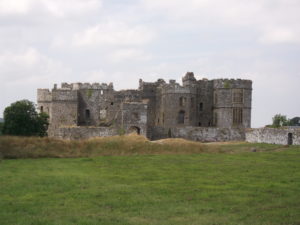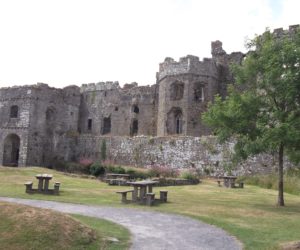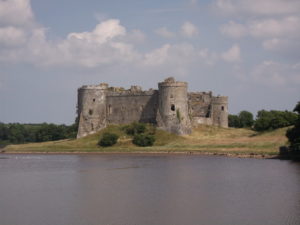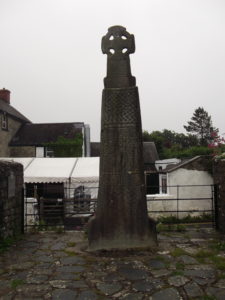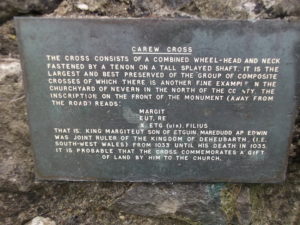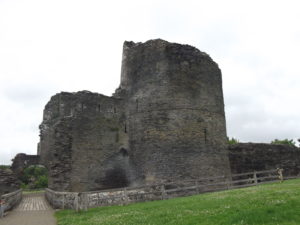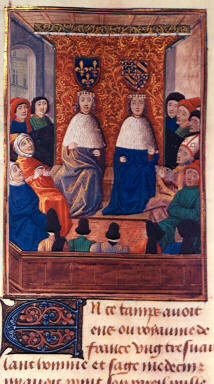First, be sure to catch up on Part 1 of Nest's story here...
Owain broke through to the sleeping area and took Nest and her children, burning the castle as he left.[23] Gerald of Wales tells us, however, that Owain raped Nest and then returned home, making no mention of Owain taking Nest with him, so there are somewhat conflicting accounts.[24] As told in the Brut y Tywysogion, though, Owain’s father Cadwgan urged Owain to return Nest to her husband, but he refused. Nest then pleaded with Owain on behalf of her children, saying: ‘If thou will have me faithful to thee, and remain with thee, send my children to their father’.[25]
It is generally considered that Owain did abduct Nest. But whether she was party to the attack as suggested by Lloyd, who states that the whole affair was a tale of passion and intrigue, or she was an unwilling victim cannot be substantiated.[26] That this was an act of rebellion against Norman incursions is a more feasible argument.
Although stories abound as to where Nest and Owain went after her abduction, no reliable evidence exists to confirm them. Susan M. Johns relies on Henry Morton’s 1932 volume In Search of Wales, which suggests that they ‘ran to Powys’ and stayed at a hunting lodge called Plas Uchaf in Eglwyseg.[27] Gwen Meredith suggests that Nest stayed with Owain for three years and that they had two sons, Llewellyn and Einion.[28] However, I would suggest that Nest was quickly returned to Gerald, possibly at the same time as her children. King Henry was rightly furious and was quick to act; taking the king’s mistress was one thing, kidnapping his son quite another. Henry brought the wrath of God down on Wales in his search for Owain by sending his man Richard de Belamais, the Bishop of London, to track Owain down. Owain escaped to Ireland, but while on the run, it would make sense that he would not have wished to be encumbered with Nest.
Nevertheless, Nest’s abduction set Wales ablaze, Normans against Welsh and Welsh against their own in a civil war. On behalf of Henry, Bishop Richard offered Owain’s cousins Ithel and Madog ab Rhiryd vast tracts of land to turn over Owain. These two invaded Ceredigion, scattering the inhabitants to any place of safety they could find and brutalising the population as they went, but they never did find Owain. It appears that later Madog changed his allegiance. Once Owain had returned from Ireland, he and Madog burned Meirionydd, killing many and slaughtering their cattle. Owain continued to be a thorn in Henry’s side and continued to avoid capture. He returned to Ceredigion, once again on the rampage, killing and terrorising as he went. In 1111, Madog ap Rhiryd killed Owain’s father, why we do not know. Owain sought revenge and caught up with Madog and blinded him.[29]
After years of constant revolt against King Henry, Owain was finally forgiven by the king and knighted in 1114.[30] A curious act by Henry, did he believe Owain could be useful to him? Owain’s meteoric rise in Henry’s favour is intriguing, especially given the statement in the Brut y Tywysogion saying that Gerald was ‘Henry’s particular friend’.[31] At this point, we may consider the vague possibility that Nest was again with Owain and was returned as a part of the bargain.[32]
In 1113, Gruffydd ap Rhys, Nest’s brother, returned from exile in Ireland determined to retake his father’s kingdom. Records show he stayed from time to time with Nest and Gerald at Pembroke Castle.[33] Young Welshmen flocked to Gruffydd’s cause as he left a trail of destruction throughout the South.[34] Henry, angered at Gruffydd’s actions, ordered Owain and Gerald to find him. Nest’s feelings regarding Gruffydd’s actions are unknown. However, that Henry would use Owain and Gerald to bring Gruffydd to heel must have felt like the ultimate betrayal.
While looking for Gruffydd, Gerald marched with his army to the forests of Ystrad-Tywi. There, Gerald came across settlers that complained to him of the brutal treatment received at the hands of Owain. Gerald decided the time was ripe to take his revenge against Owain. Believing that Gerald had come to assist in bringing down Gruffydd, Owain was instead attacked by Gerald’s forces with a volley of arrows.[35] Owain died from an arrow to his heart, which, given his passion for Nest, seems quite fated.
No mention is made in the chronicle evidence of what happened to Gerald at this point. Had he died alongside Owain, it would have been recorded along with Owain’s death. Was Gerald injured in the skirmish and died later from his wounds? History does not tell us. Plausible is the idea that Henry’s actions towards Owain were considered by Gerald a betrayal. It could also be that Gerald was tired of sharing his wife with so many men, the king included, and took his frustration out on Owain and left court.[36] His options would have been few if he wished to keep his family safe and secure. It is possible that he took up the cross and travelled to the Holy Land, but we simply do not know.
D. Walker tells us that Gerald died in 1136.[37] However, William Hait became the constable of Pembroke in 1130,[38] which suggests that Gerald was not in residence at the time. This strengthens the argument that Gerald had either fled, died, or was suffering a prolonged illness that took him out of the record books.
Of Nest’s potentially fourteen children, history does not give reliable dates of their births or their deaths. That she had four children by Gerald is documented by various sources; that she had ten further children is less easy to confirm. She bore Hait, the Constable of Pembroke, a son, William Lord of St. Clears. She also had a son, Robert Fitz Stephen, by Stephen, the Constable of Cardigan, whom she had married after Gerald’s death. While their birth dates may not be reliably documented, they feature prominently in history. There were four further children by fathers unknown, plus the possibility that Nest also had two sons by Owain.
It would be easy to label Nest as promiscuous, given the number of children she had by various men, but the fact that we have no firm evidence of the dates they were born does allow for us to be a little more lenient towards her. I have often considered her unfairly treated in the scholarship. She was forced into situations that were beyond her control, as was the case for many women in the Middle Ages, and that she used the beauty and charms she possessed to make a comfortable and safe life for herself and her children would have been very reasonable, given her circumstances. We must also consider that it would have been prudent for the king to see his mistress married successively to two Norman lords (Gerald and then Stephen), thus keeping her and her children under his influence. Being a daughter of the King of Deheubarth made her a target for those who would use her as leverage against the Normans.
We have no reliable evidence for the date of her death, nor do we know where she is buried. What we do know is that she left a legacy that has survived through time by means of her children and grandchildren. If Nest herself is not remembered well by the historians, her children by the various men in her life have been. They were born with a mixture of both Welsh and Norman blood in their veins and went on to lay the foundations for some of the major houses in both Wales and Ireland. Nest and Gerald’s daughter Angharad married William Fitz Odo de Barry, and their son, Gerald de Barry, is better known to us as the prolific writer and priest Gerald of Wales. Robert Fitz Stephen and his half-brother, Maurice Fitz Gerald, ensured a long line of Fitz Geralds in Ireland by successfully gaining vast tracts of land through either battle or reward. They built castles and established a lasting Fitz Gerald dynasty, which includes the 35th President of the United States, John Fitzgerald Kennedy.
Patricia Taylor, M.A.
University of Wales Trinity Saint David
Footnotes
[23] Annales Cambriae, p.76.
[24] Giraldus Cambrensis, Expugnatio Hibernica: The Conquest of Ireland, edited and translated by A. B. Scott and F. X. Martin (Dublin: Royal Irish Academy, 1978), pp.229-30.
[25] Brut y Tywysogion, p.87.
[26] Lloyd, History of Wales, Volume ii, p.417-48.
[27] Johns, Gender, Nation and Conquest in the High Middle Ages, pp.196-198. Henry Morton was a travel writer who took pleasure in portraying Wales as a place of romance and legends to entertain his readers. However, there is an Elizabethan manor house in Eglwyseg known as Plas Uchaf built on the foundations of a hunting lodge which once belonged to the princes of Powys. An inscription can be seen over the door telling how the lodge was inherited by the princes of Powys in 1073.
[28] G. Meredith, ‘Henry I’s Concubines’, Essays in Medieval Studies 19 (2002): p.17. Available: http://muse.jhu.edu/article/39657. Access provided by University of Wales Trinity Saint David. <accessed 4th July 2016>.
[29] Annales Cambriae, p.76.
[30] Brut y Tywysogion, p.119.
[31] Brut y Tywysogion, p.87.
[32] P. A. Taylor, Nest Ferch Rhys ap Tewdwr, p.33.
[33] Lloyd, History of Wales, Volume ii, p.433.
[34] Brut y Tywysogion, p.123.
[35] Rev. W. Warrington, The History of Wales in Nine Books, vol.1, Bk. V (Brecon: Williams, 1823), p.432.
[36] Johns, Gender, Nation and Conquest in the High Middle Ages, p.22.
[37] D. Walker, ‘Gerald of Windsor (d. 1116×36)’, Oxford Dictionary of National Biography (2004) [online]. Available: http://www.oxforddnb.com/view/article/45551. <accessed 23rd November 2016>.
[38] Lloyd, History of Wales, Volume ii, p.424.


